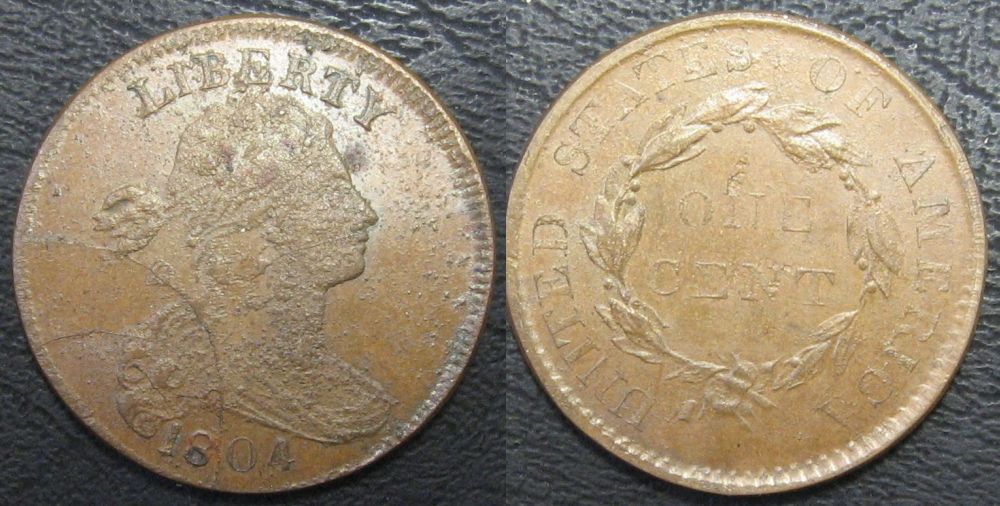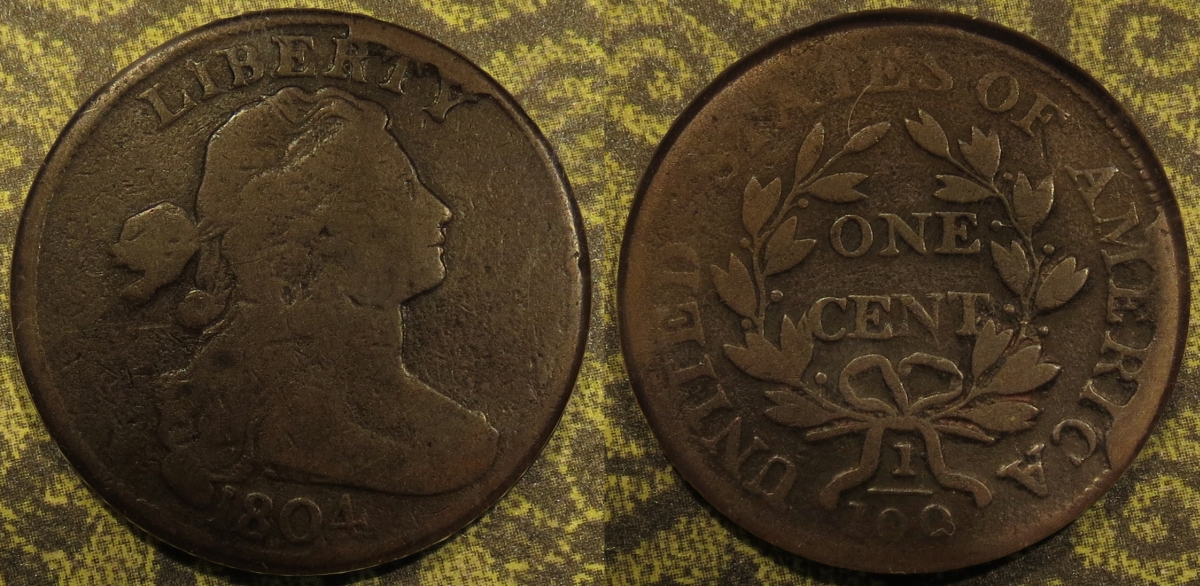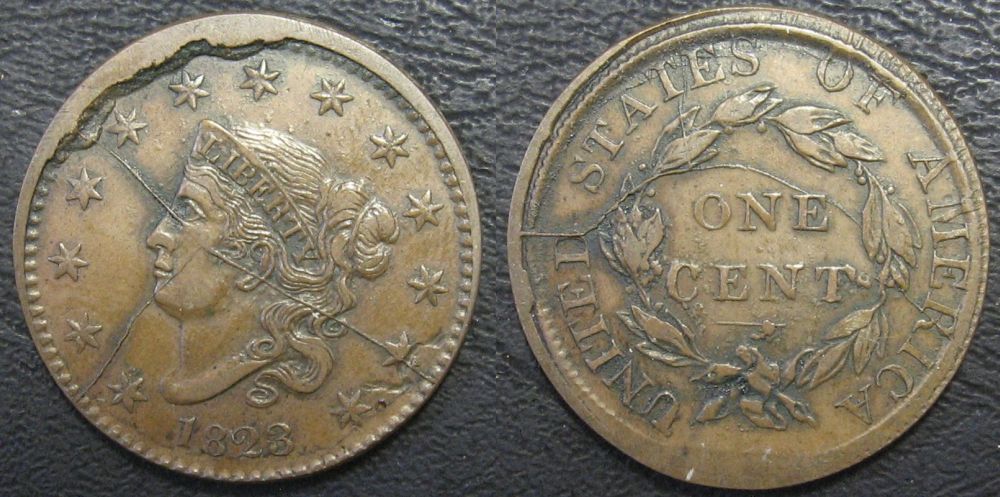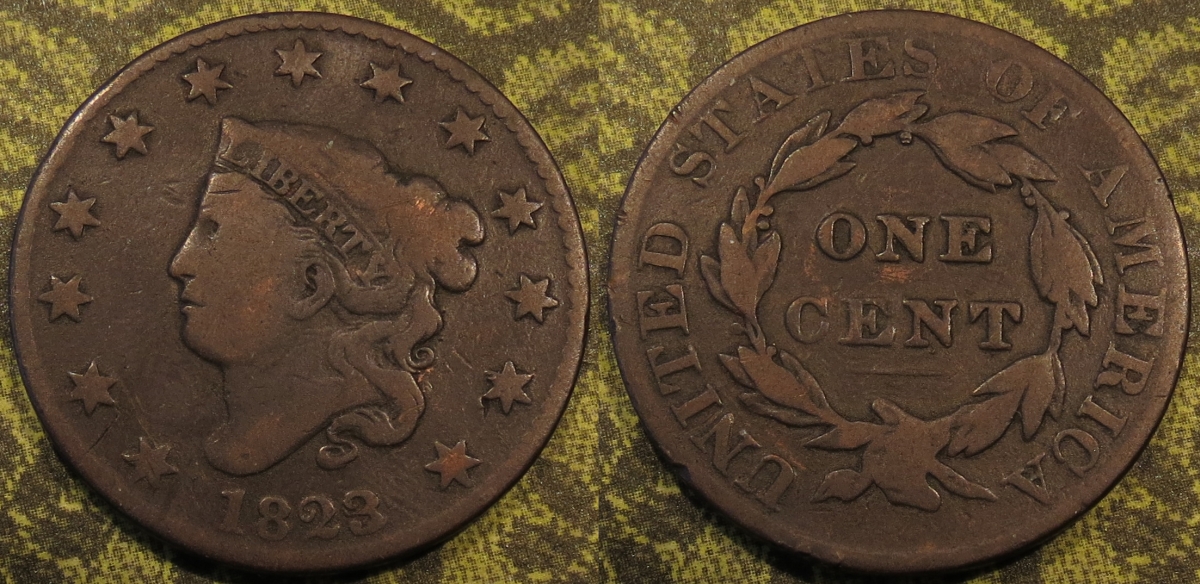Options
1804 and 1823 large cents: real ones and "restrikes"
 rhedden
Posts: 6,632 ✭✭✭✭✭
rhedden
Posts: 6,632 ✭✭✭✭✭
Two curious items that have long been collected as part of the large cent series are the 1804 and 1823 "private restrikes." We previously discussed these restrikes in a post I made in June of 2010, but I thought it was worth revisiting them because few people are familiar with them and the pictures are gone from the old thread. I have added mages and some additional information to the 2016 version.
The "private restrike" coins are not U.S. mint restrikes, but old counterfeits that were manufactured by an unknown party who had access to discarded dies from the mint. The 1823 is believed to have been struck in the 1860s and 1870s, with later die states such as my example being produced in the 1870s. The 1804 was possibly produced around 1860. Joseph Mickley's name has been mentioned as a possible coiner, but I don't think anyone knows for sure, as the coiner would not likely have advertised his work far and wide.
One can speculate whether these coins were produced as novelties, or if they were fakes that were meant to deceive novice collectors. Sheldon certainly thought it was the latter. If so, it was not a very good effort, as they look nothing like the originals. The 1804 actually has an 1803 obverse die with an altered date, with the reverse of an 1820 Coronet Head cent, while the 1823 is often found with huge die cracks and a rim break. I have included my examples of the real deal for both dates for comparison. The 1804 cent is ANACS VG-8 (old white holder) and the 1823/2 is a raw VG-8.
As far as grading the restrikes goes, my 1823 is AU55 and the 1804 is MS63 by current standards. Needless to say, grading fake coins struck from cracked up or rusted dies poses a challenge, and opinions may vary. PCGS does recognize these coins and grade them, assigning them PCGS# 45344 (1804) and PCGS# 81627 (1823). Surviving populations are estimated at 1000 pieces (1804) and 200 pieces (1823) by PCGS, but certified populations are closer than these numbers would suggest. Using the set registry feature, I found that PCGS has graded forty 1804 restrikes and thirty-four 1823 restrikes over the years, but I do not believe either issue actually exists in the population report, interestingly enough. Most of the certified coins grade AU-something to MS66 for both issues. These coins did not circulate much for obvious reasons.
My 1823 is interesting in that it was struck in a later die state than what is called "terminal" die state VI. In fact, my coin is the latest die state I have ever seen. The extreme obverse cud and flattening of the reverse rim, as well as the obverse field gouges between stars 12 and 13, are features of the coin as-struck. I have seen two other examples with the field gouges in the same exact place, oddly enough, which suggests there was some sort of raised metal adhering to the dies at that point in their life. I have never seen another example with the rims so far gone; please post a link if you know of one in an even later die state. Otherwise, I will just label mine "beyond terminal," which would probably also be a good way to describe my US coin collecting.




The "private restrike" coins are not U.S. mint restrikes, but old counterfeits that were manufactured by an unknown party who had access to discarded dies from the mint. The 1823 is believed to have been struck in the 1860s and 1870s, with later die states such as my example being produced in the 1870s. The 1804 was possibly produced around 1860. Joseph Mickley's name has been mentioned as a possible coiner, but I don't think anyone knows for sure, as the coiner would not likely have advertised his work far and wide.
One can speculate whether these coins were produced as novelties, or if they were fakes that were meant to deceive novice collectors. Sheldon certainly thought it was the latter. If so, it was not a very good effort, as they look nothing like the originals. The 1804 actually has an 1803 obverse die with an altered date, with the reverse of an 1820 Coronet Head cent, while the 1823 is often found with huge die cracks and a rim break. I have included my examples of the real deal for both dates for comparison. The 1804 cent is ANACS VG-8 (old white holder) and the 1823/2 is a raw VG-8.
As far as grading the restrikes goes, my 1823 is AU55 and the 1804 is MS63 by current standards. Needless to say, grading fake coins struck from cracked up or rusted dies poses a challenge, and opinions may vary. PCGS does recognize these coins and grade them, assigning them PCGS# 45344 (1804) and PCGS# 81627 (1823). Surviving populations are estimated at 1000 pieces (1804) and 200 pieces (1823) by PCGS, but certified populations are closer than these numbers would suggest. Using the set registry feature, I found that PCGS has graded forty 1804 restrikes and thirty-four 1823 restrikes over the years, but I do not believe either issue actually exists in the population report, interestingly enough. Most of the certified coins grade AU-something to MS66 for both issues. These coins did not circulate much for obvious reasons.
My 1823 is interesting in that it was struck in a later die state than what is called "terminal" die state VI. In fact, my coin is the latest die state I have ever seen. The extreme obverse cud and flattening of the reverse rim, as well as the obverse field gouges between stars 12 and 13, are features of the coin as-struck. I have seen two other examples with the field gouges in the same exact place, oddly enough, which suggests there was some sort of raised metal adhering to the dies at that point in their life. I have never seen another example with the rims so far gone; please post a link if you know of one in an even later die state. Otherwise, I will just label mine "beyond terminal," which would probably also be a good way to describe my US coin collecting.




0
Comments
Very interesting '23 Restrike - I never saw one like that either.
not that i am the hurdle that needs be surmounted but im not on board that the 1823 and probably the others are from us mint dies.
the devices dont match to my eyes.
i may need to do some side-by-sides to get me there. perhaps the 1823 dies were off a little from the norm.
nuances abound.
cool coins and post whatever the verdict.
.
let me rephrase.
when i said others, i meant the 1823 other restrikes.
im not sayin' nuttin' about the other dates/types, at this time.
only 1 ego trip at a time.
im sure greater and more experience minds have ran these to ground but ive seen and done enough in my little circle to at least have some fun with it, especially considering hiw off the 1823 looks to my eyes.
got some images to start and images of all known die marriages.
either i'll come back with some relevant info or my tail tucked between my legs. o:
either way, should be fun.
.
Neat stuff. I too have never seen so "extra terminal" a die state as on that 1823, but I've barely seen any of this variety at all.
this was probably already known but the 1823 is not from usa dies.
i should have just stated it yesterday as no way are those letters the standard of the mint, even with patterns.
my saying this could be irrelevant.
anyone wanting more info, just look how far off the many details are from the 2 known pairs.
ok, ive said my peace and please go back to your regularly scheduled programming.
tracking the die stages is neat. it seems they destroyed these dies fairly quickly but they probably werent tempered or whatever to begin with.
added
cf bn - cf rb
.
all being said, id like to own a few of these one day. perhaps a die stage set.
.
rainbowroosie April 1, 2003
siliconvalleycoins.com
Yours is spectacular, coinlieutenant. That must have been an outstanding collection to have had a coin of that magnitude in it.
This date (as the N-2 non overdate) and the 39/6 are the toughest of the middle dates, and almost unattainable higher than VF.
My 1823 is uber original. Lots of gunk in the crevaces while still retaining wonderful surfaces. It really is a special coin.
I actually got a phone call about 30 minutes ago from the same gentleman who has decided to sell the rest of the collection. Silver dollars are all that remain. One thousand eight hundred and twenty three of them.
siliconvalleycoins.com